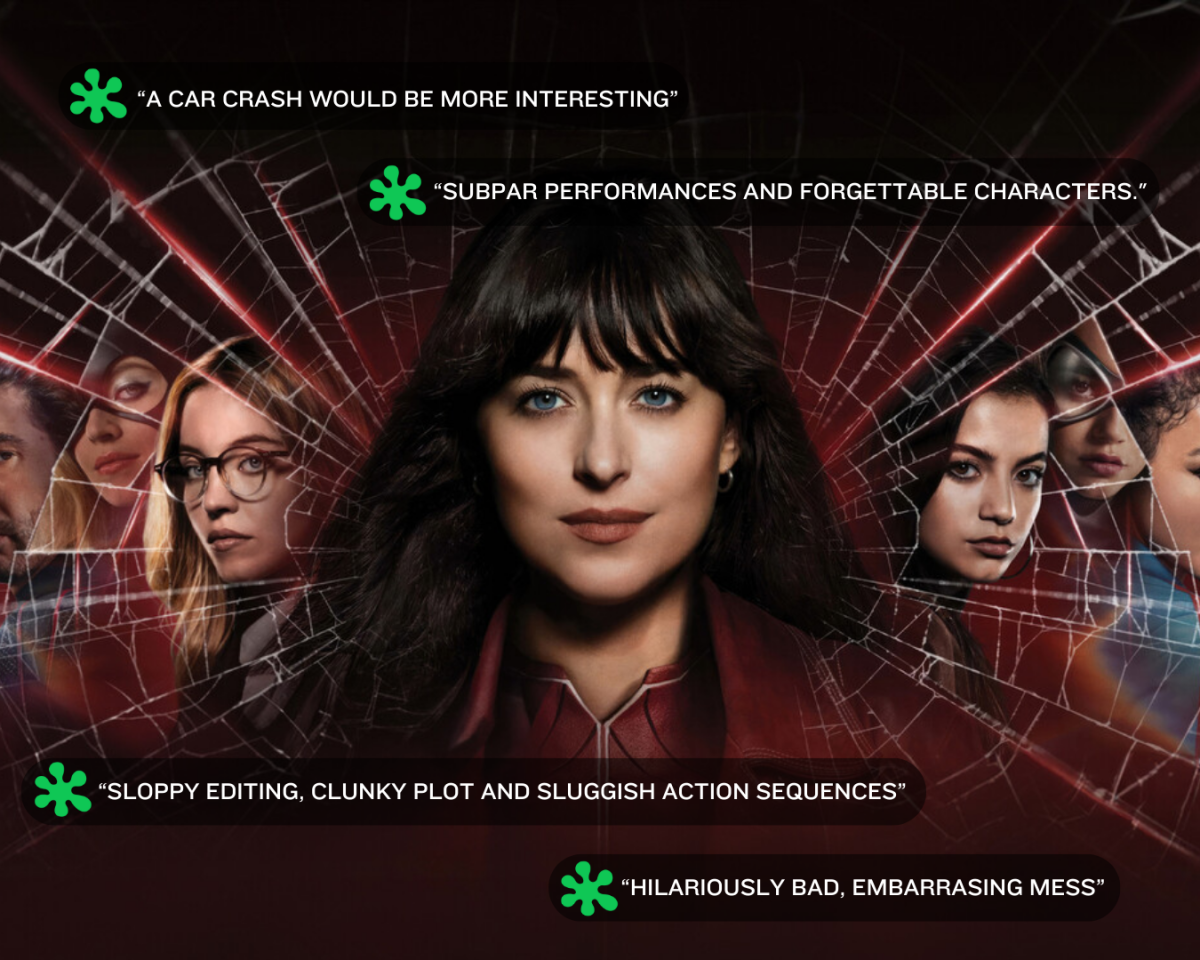
This review contains spoilers.
“Dune: Part Two” came out on March 1 and has already grossed $178.5 million at the global box office as of March 7. This makes it one of the most successful opening weekends for a film since “Barbie” (2023) and “Oppenheimer” (2023). Featuring a star-studded lead cast consisting of Timothée Chalamet, Zendaya, Florence Pugh and Austin Butler, the film exceeded all expectations.
Unsurprisingly, Director Denis Villeneuve seamlessly translated parts one and two onto the screen. While certain plot elements surrounding Alia Atreides (Anya Taylor-Joy), Gurney Halleck (Josh Brolin) and Chani Kynes (Zendaya) were changed or erased altogether, the film excellently captured Frank Herbert’s vision for Paul Atreides, played by Chalamet.
The opening scene featuring Alia — also known as Saint Alia of the Knife — was beautiful in terms of cinematography and drama. The close-up shots with her voice-over speaking on the events throughout the film conveyed her all-seeing abilities. I was curious about how the film would handle her character, considering the novel’s dedicated parts from her perspective. The segments showing her as a computer-generated imagery (CGI) embryo in the womb with voice-overs were especially enjoyable. Artistically, choosing to open the film with the all-knowing and seeing character Alia — portrayed as both an embryo and her future self in Paul’s visions — to everyone but the audience was a creative and effective choice.
I was also delighted by Taylor-Joy’s portrayal of future Alia in the scene where Paul drinks the Water of Life. She — along with everyone else in the cast — looked exactly as I envisioned based on the books’ descriptions.
The cinematography was stunning. The majority of the movie’s sets were practical and authentic, which was quite refreshing for science fiction and action movies, as they usually tend to rely on CGI or visual effects. The glittering dunes, caves and cliffs were beautiful. My favorite shot sequences are the scenes with the Baron and the Fremen. I loved the white-and-black sequence of Feyd-Rautha Harkonnen, played by Butler, fighting in the ring with the mob of black and white Harkonnen onlookers, highlighting Feyd-Rautha’s size and power. At the same time, the scene where Paul and Chani kiss among the panning infinite sea of sand was a tender moment, reflecting the boyishness in the protagonist before he is consumed by prophecy.
One standout scene is when Paul moves through the masses of Fremen, seamlessly blending in with the crowd. The downward tilt of the camera shows an aerial sequence of Paul embracing himself as both Muad’dib and the Kwisatz Haderach while leading the Fremen to war. I loved that the Fremen’s language was subtitled for the audiences by the director himself and not through translation companies; this ensures that the message behind Paul’s speech would not be lost in translation.
The cinematography and music composition by Hans Zimmer conveyed every nuance of emotion. I was immediately immersed in the dystopian world, watching the Fremen travel across the desert; their ragged capes billowing in the wind as they rode the sandworm (another fantastically-shot sequence). The screenplay and soundtracks brought the story to life — a rare occurrence in literature-to-film adaptations. The acting, as expected, was on par. As a Marvel Cinematic Universe and “Mission: Impossible” series fan, it was great to see so many familiar faces delivering outstanding performances once again.
Zendaya truly captured the essence of Chani. Her portrayal was convincing in every aspect of the character, whether in combat, flight or emotion. One standout scene is when she interrupts Naib Stilgar and the other Fremen during prayer, passionately begging the Fremen to turn away from their strong belief in Paul as the Messiah.
Even though I wasn’t the biggest fan of Lady Jessica in the novel, Rebecca Ferguson’s portrayal allowed me to access and appreciate the character more. She brought nuance and insight that might have been overlooked when reading the novels’ hundreds of pages. I loved seeing her toughness and manipulative side, showing why she was a Bene Gesserit. I loved seeing her path to becoming a Reverend Mother and the tactics she used. I also appreciated how her character arc and growth contributed to Alia, who is one of the most interesting characters in the franchise.
I found the change in the movie where Gurney doesn’t easily believe that Lady Jessica would betray the House of Atreides to be a positive deviation from the book. It was more effective in showing the villainous side of Lady Jessica as a Reverend Mother.
I was excited to see Feyd-Rautha onscreen and was worried about how well Butler would portray the role. However, in the end, he was the perfect actor for the job. He brought out the psycho warrior that Feyd-Rautha was, even though I could still hear hints of the character of Elvis Presley, whom he portrayed in the 2022 biographical drama “Elvis.”
The most striking performance was Chalamet’s. I wasn’t really a fan of his work before, but after watching both parts of “Dune,” he is the perfect Paul. He portrayed not only the character but all of the movie’s themes with immense delicacy and authenticity. He captured the essence of the heart, mind and soul of Paul, Muad’dib and Kwisatz Haderach — extensions of three very different characters.
Chalamet embodied the character and the journey that Paul experiences perfectly, highlighting the impacts of faith, colonialism, war, justice and vengeance. I can pinpoint the exact moments in the movie where Paul becomes the Muad’dib and then the Kwisatz Haderach. Even better, these are the same moments highlighted in the novel.
Moreover, the transitions throughout the film were seamless. The initial flashes of Alia in the womb to her progression of her already-blue eyes being open, Paul’s visions amid the prayer and fight scenes all flowed smoothly amid the activities of Princess Irulan — played by Florence Pugh — and the antagonists. I love how clear the shift in character for Lady Jessica is, but especially so for Paul once he is given the Water of Life, enabling their prophetic counterparts as the Reverend Mother and Kwisatz Haderach, respectively.
I also appreciated the major directorial differences from the novel. In the novel, Chani is portrayed as more accepting of Paul as the Kwisatz Haderach, and they have a son who dies. However, the movie offers a fresh take on Paul and Chani’s relationship dynamics and the events unfolding around them. Alia is also born around this time as the events of the novel are more stretched out instead of the condensed days and weeks covered in the movie.
I liked that Chani was given a larger role and that she was able to find some form of an ally in Gurney. The movie establishes her character as one of the few who do not believe in the prophecy of the Kwisatz Haderach.
Chani’s defining line, “I will stay by your side as long as you stay who you are,” adds depth to her character because, in the books, she fights for Paul and their love and doesn’t really have a voice. Once Paul becomes the prophetic character as a result of the Water of Life, she pulls herself away from him, eventually leaving him at the end of the movie — marking a significant character change.
I think this will be very interesting for the Messiah for two reasons. First, if the movie had followed the novels’ routes, Chani would have carried a very different presence; it would have been interesting to explore her and Paul having a child, even if briefly, given the child’s short-lived existence in the story.
Second, once Paul becomes the Kwisatz Haderach, he appears less focused on Chani, loosely remarking to his mother that she will come around as he sees her in his future. This is especially noteworthy since he also takes Princess Irulan’s hand in marriage at the end of the movie.
In the novel, Brolin’s Gurney is kidnapped when the House of Atreides falls. Gurney is then manipulated into believing that Lady Jessica betrayed Paul and his father; when he stumbles upon Paul and the Fremen, he tries to kill Lady Jessica several times. The absence of this subplot allowed the film to flow better to focus on Paul’s story.
The final scenes of the movie deserve credit. The buildup to Paul seeking revenge on the Baron and the Emperor was quite tasteful, and the movie did the fight between him and Feyd-Rautha justice. I loved how once Paul establishes himself as Emperor, everyone kneels except for Chani and Princess Irulan, who stand on opposite sides before Chani walks out. This scene was both empowering and emotional for the two women who will face several difficult challenges. These challenges include navigating the new power dynamics introduced by Paul, Chani will become Paul’s lover and concubine, while Princess Irulan will enter into a political marriage with Paul so he can ascend the throne.
Chani loves Paul, yet once she sees what he has become — the very enemy of the Fremen that she is meant to protect — she begins losing that love. Paul embraces the prophecy and takes Princess Irulan’s hand in marriage. Princess Irulan knows that Paul loves Chani and she is a mere pawn, which she intends to exert back on. It was a beautiful scene with the composition, the soft camera panning and what the scene meant to the franchise and the characters as a whole.
This movie was exciting and engaging, showing Paul’s rise and inevitable looming fall. “Dune: Part Two” was more than I could’ve imagined and was a brilliant take on the novel. It has easily become one of my favorite movies, and I cannot wait for the third installment in the franchise.

















